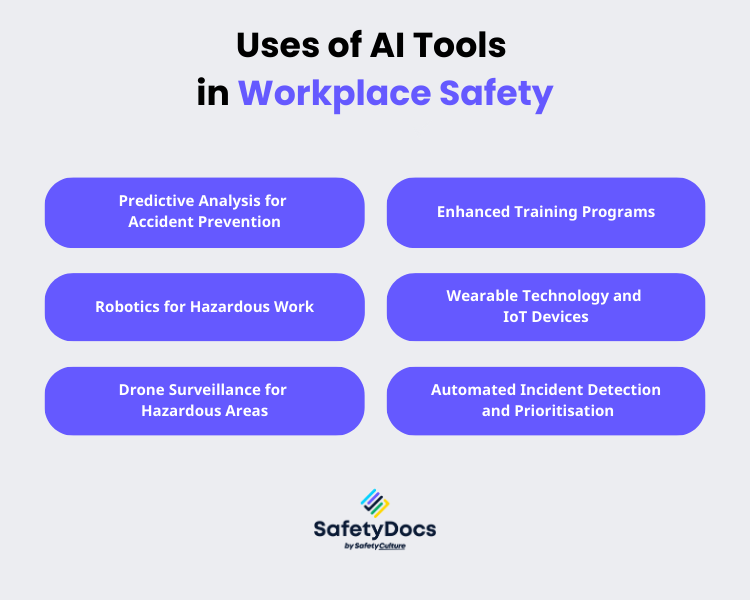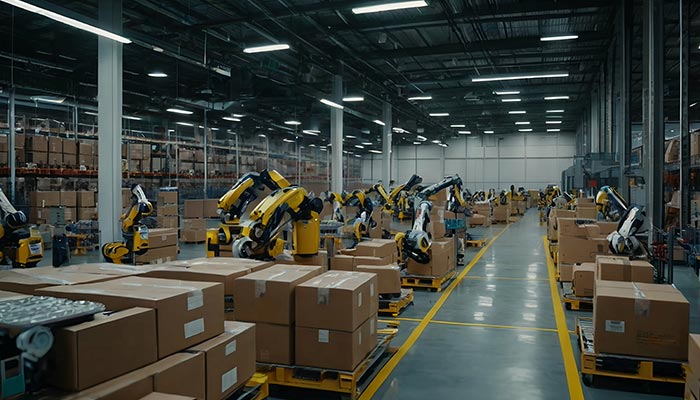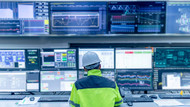Artificial Intelligence (AI) in workplace safety has rapidly transformed from a futuristic concept into a tangible reality. Examples include AI-enabled wearable devices that can track workers' vital signs, such as heart rate, body temperature, and fatigue levels, in real time. Such ideas are no longer limited to sci-fi movies. However, they are now being implemented in various industries to improve safety protocols and mitigate risks.
How AI Works for Workplace Safety
Artificial intelligence has immense potential to improve workplace safety across various industries by leveraging:
Data Analysis
AI algorithms can analyse data, including worker behaviour patterns and environmental conditions. It works by identifying correlations and trends that humans may not have noticed. For example, AI can flag potential hazards based on past incidents, near-misses, and workplace observations.
Health and safety professionals have been striving to achieve this predictive analytics approach to enhancing safety measures for years. It provides a powerful tool to proactively identify, predict, and prevent potential hazards before they result in accidents or injuries.
Automation
Artificial intelligence can automate repetitive tasks, freeing workers to focus on more complex and safety-critical activities. This reduces the risk of human error and allows for better resource allocation in high-risk areas. For example, AI can automate safety inspections and identify potential issues that require immediate attention.
Robotic systems equipped with AI can also handle high-risk activities, such as working with toxic chemicals, operating in extreme temperatures, or performing repetitive, injury-prone tasks.

Real-Time Monitoring
AI technology lets you monitor what's happening in your workplace in real-time. AI-powered cameras and sensors can capture critical data such as worker movements, equipment usage, and environmental conditions. AI can detect unsafe conditions or behaviours through real-time monitoring and raise the alarm to prevent accidents.
When a potential hazard is identified, the system can trigger alerts, initiate safety protocols, and even shut down machinery to prevent accidents. This instantaneous feedback loop ensures that safety issues are addressed promptly, reducing the severity and frequency of incidents.
Uses of AI Tools in Workplace Safety
Here are examples of how artificial intelligence was utilised to enhance our workplace safety practices:
Predictive Analysis for Accident Prevention
Predictive analysis using machine learning and AI can transform industry safety by analysing historical data to predict potential incidents and identify risk factors. For example, AI can analyse truck drivers' patterns in the logistics sector, such as driving hours, speed, and fatigue, to forecast potential accidents and recommend preventive measures.
Hospitals use AI to predict patient deterioration by analysing vital signs and other health data. This approach enhances patient safety and reduces the workload on healthcare professionals by allowing timely interventions. For example, Johns Hopkins Hospital has implemented an AI-based system that predicts septic shock, providing early warnings to save lives.
Enhanced Training Programs
Artificial intelligence is also revolutionising workplace health and safety training programs, making them more interactive and practical. Virtual Reality (VR) and AI offer immersive training experiences where workers can practice handling unsafe situations in a controlled, realistic environment. For instance, the mining industry has adopted VR training modules powered by AI to prepare miners for emergency evacuations and equipment handling without exposing them to real-world dangers.
Similarly, AI-driven simulators provide pilot training for emergency scenarios in the aviation industry, significantly improving preparedness. Companies like Boeing use AI to create personalised training schedules that adapt to each pilot's learning pace and style, ensuring they are well-equipped to handle safety-critical situations.
Robotics for Hazardous Work
Using robotics in high-risk activities has significantly increased workplace safety. AI robots can do risky tasks, lowering the chance of human harm in dangerous spots. For example, robots equipped with AI technology can now perform inspection, maintenance, and repair work on oil rigs, nuclear plants, or space stations.
Wearable Technology and IoT Devices
Wearables and Internet of Things (IoT) devices include smart helmets, vests, and wristbands that monitor workers' vital signs, such as heart rate, body temperature, and fatigue. For instance, smart helmets can alert supervisors to potential health and safety risks, like heat exhaustion in the construction industry.
In the healthcare sector, wearables track nurses' movements and help manage their workloads to prevent burnout. Similarly, smart gloves equipped with sensors in manufacturing can detect harmful vibrations from machinery and alert workers to take breaks, thereby preventing long-term injuries.
Drone Surveillance for Hazardous Areas
Drones offer a bird's-eye view that can be crucial for monitoring hazardous areas safely and efficiently. In construction, drones can fly over sites to inspect scaffolding, structural integrity, and worker safety from above. This speeds up the inspection process and mitigates the risk of falls or accidents during manual inspections.
Drones are also invaluable for inspecting pipelines and rigs within the oil and gas sector. These environments can be hazardous due to high pressure and the risk of explosions. Drones can patrol these areas, identify leaks, and detect faults early, significantly enhancing safety protocols.
Automated Incident Detection and Prioritisation
In emergency response, AI can automatically detect and prioritise incidents based on severity, location, and potential impact. AI systems can listen, transcribe, and analyse emergency calls in real time using Natural Language Processing (NLP). This allows for rapid extraction and classification of crucial information, such as the nature of the emergency, location details, and the caller's state of distress.

AI is undeniably a helpful tool in improving workplace safety, but it presents challenges and ethical considerations when implementing it. Some of these include:
1. Data Privacy and Security
Using AI in workplace safety raises significant concerns about data privacy and security. AI systems rely heavily on collecting and analysing vast amounts of data, often including sensitive information such as employees' health records. Companies must ensure that this data is collected, stored, and used ethically.
2. Algorithmic Bias
The data used in AI algorithms can unintentionally propagate or even intensify existing biases. The AI system might make unfair predictions or recommendations if historical safety data reflects biased reporting practices. For instance, if certain groups do not report minor injuries, the AI might underestimate safety risks for those groups, leading to inadequate safety measures.
3. The "Black Box" Problem
The "black box" problem refers to the challenge of understanding how AI systems arrive at their decisions. AI models, particularly deep learning ones, can be highly complex. The lack of transparency can breed mistrust among safety personnel and managers when they don't understand why an AI system made a particular recommendation or prediction.
4. Human-AI Collaboration
Human-AI collaboration in workplace health and safety often means integrating AI tools and systems to work alongside human employees. While AI offers potent capabilities in data analysis, predictive analytics, and real-time monitoring, it also introduces new dynamics in the human workforce.
One of the primary challenges in human-AI collaboration is ensuring that the AI systems complement rather than replace human judgement. Furthermore, there is a potential for over-reliance on AI, where workers might become complacent, assuming that the AI system will catch every potential hazard.
5. Job Displacement
Automating hazardous tasks through AI can lead to job displacement, particularly in roles traditionally associated with manual labour. This raises concerns about the economic and social impacts on affected workers. Organisations should consider strategies to support workers displaced by AI, such as reskilling programs, job placement assistance, and creating new roles that combine human skills with AI technologies.
Future of AI in Workplace Safety
Integrating AI in workplace safety promises to revolutionise how we protect workers and prevent accidents. Below are key trends anticipated for the future of AI in enhancing workplace safety:
- Automated safety checks and predictive modelling will use AI systems for constant monitoring, real-time responses, and standard compliance with safety protocols.
- Wearable devices and sensors will become more prevalent in real-time worker health and safety monitoring.
- Computer vision and environmental monitoring will detect anomalies, unsafe practices, or unauthorised access to restricted areas and trigger immediate alerts or corrective actions.
- Collaborative robots (cobots) will perform dangerous tasks like handling toxic substances or operating in extreme environments, reducing the risk to human workers.
- AI-driven training will increase, using interactive simulations and virtual reality to boost learning and retention.
- Exoskeletons and assistive devices will minimise strain and fatigue and enable individuals with disabilities to perform tasks they previously found challenging.

The regulatory landscape in Australia is still developing to keep pace with the adoption of AI in the workplace. Currently, there are no set rules for AI use in workplace safety. However, the Australian Government released an AI Ethics Framework outlining eight principles for ensuring AI is used safely and reliably in government.
Until new AI regulations are introduced, businesses in Australia should follow existing laws on privacy, consumer protection, discrimination, surveillance, and defamation. Compliance with these laws is essential when adopting AI.
Balancing Innovation and Human Element
Although AI offers rich tools and notable progress, it is necessary not to lose sight of the human element in occupational safety. AI should complement and enhance human capabilities rather than replace them. The ethical considerations discussed must guide its use.
Human judgement, expertise, and AI technologies should work together and not be seen as competing approaches. In the end, the goal is to create a safer workplace for all. AI can be an invaluable asset in achieving that goal with responsible use.
Lead the Way in Building a Safety-First Culture
No matter how advanced the technology is, creating a safety-first culture starts with strong leadership and clear communication. SafetyDocs by SafetyCulture can help you develop a culture of safety and compliance with our safety products.
Our comprehensive library of safety documents, from risk assessment to safe operating procedure templates, coupled with our expertise in safety management systems, provides a solid foundation for fostering a proactive safety culture. Explore our insights and expert guidance to help create a workplace where everyone feels valued, protected, and empowered.
Our team of experts is dedicated to providing accurate and informative content. Craig Cruickshank, our senior HSEQ advisor at SafetyDocs by SafetyCulture has reviewed this blog post to ensure the highest level of quality.
Learn more about Craig's work on LinkedIn for more industry insights.
Available for instant download and supplied in fully editable MS Word format for use in your business.
Please note that the above information is provided as a comment only and should not be relied on as professional, legal or financial advice.
Share This Article
